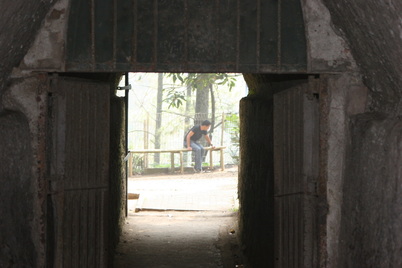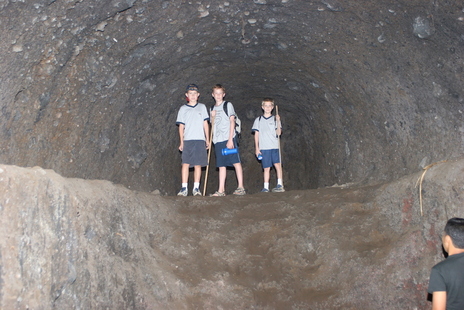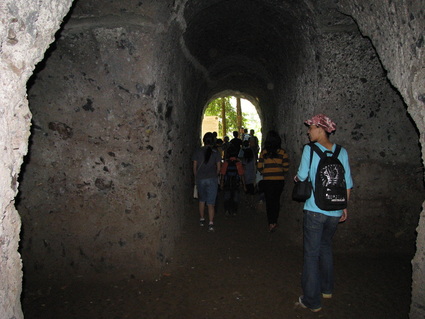Photo by Gerrit Hansen: Ecola State Park, Cannon Beach, Oregon
THE POWER OF ANCIENTS
If you love triumphing over adversity
If you love adventure
If you love creativity
If you love freedom
If you love discovering new places
Then you'll LOVE The Power of Ancients
If you love adventure
If you love creativity
If you love freedom
If you love discovering new places
Then you'll LOVE The Power of Ancients
The Power of Ancients is a historical fantasy series weaving together elements of Javanese culture, history, legends (Dayang Sumbi/Sangkuriang), myths, and current practices, as well as hints of peoples from Sumatra. The story is set in a stone tower atop Mount Sunda in West Jawa (Java) during pre-Hindu times (the remains of the mountain today are known as Mount Tangkuban Perahu, Burangrang, and Bukit Tunggul). Lake Bandung is still in existence in this narrative. Mount Semeru, Mount Slamet, Mount Karang, and other authentic place names come into the story. All character names reflect the regions they come from, and Batak names are used for the Jupami tribe.
Read about Questions answered in The Power of Ancients (Indonesian and English)
Short Synopsis / Pitch
Maruli, a young tribal villager from the island of Java leaves his remote jungle home to study ilmu, a form of magic he hopes will help save his island from its nemesis, Dahat, a member of a powerful ancient race that’s nearly extinct. Ilmu requires grinding up special stones believed to be the remains of that same ancient race.
A young magic wielder named Tala mentors Maruli, and together, they become powerful. But after several disastrous battles against Dahat that nearly cost Maruli his life, they realize their magic isn’t strong enough to defeat the enemy. They secretly venture into forbidden research and discover that hundreds of the ancient race are imprisoned in the stones they’ve been grinding up for ilmu.
Defying their elders, Maruli and Tala lay aside their pursuit of ilmu and travel to a hidden valley in the island’s interior to obtain the elements for freeing the imprisoned race in hopes that they’ll join them in battling Dahat. But will their efforts unleash an even greater terror?
A young magic wielder named Tala mentors Maruli, and together, they become powerful. But after several disastrous battles against Dahat that nearly cost Maruli his life, they realize their magic isn’t strong enough to defeat the enemy. They secretly venture into forbidden research and discover that hundreds of the ancient race are imprisoned in the stones they’ve been grinding up for ilmu.
Defying their elders, Maruli and Tala lay aside their pursuit of ilmu and travel to a hidden valley in the island’s interior to obtain the elements for freeing the imprisoned race in hopes that they’ll join them in battling Dahat. But will their efforts unleash an even greater terror?
Full Synopsis: The Power of Ancients
Crippled children in the Jupami tribe are cast into the river and forever forgotten, but Maruli’s parents broke with tribal customs and spared him. At twenty-one, his life takes a dramatic turn when a group of mages visit his remote jungle village in ancient Java, recruiting village youths who possess the rare aptitude for ilmu, the magic they study, to join their fight against the island’s nemesis, an immortal Ancient named Dahat. Surprisingly, Maruli exceeds everyone’s expectations, and the mages urge him to study ilmu in Menara, a stone fortress located on Mount Sunda where a community of nearly two hundred practitioners are developing magical skills to defend the island’s villages against Dahat’s murderous hand.
As Maruli prepares to leave for Menara, one of Dahat’s agents nearly kills him. A benevolent Ancient infuses Maruli with his “lifesource” which not only saves him from death, but also completely heals the youth’s crippled arm and shoulder.
The leadership of Menara tasks Tala, an attractive young mage, with mentoring Maruli. But, unknown to them, she’s a renegade mage ousted from Menara years earlier because she embraced the forbidden teaching that Quassani stones, the necessary element for performing ilmu, are not inanimate objects, but living imprisoned Ancients. Using protean lore, she has disguised her true identity to establish the completely new persona of Tala in order to re-enter the community of mages and resurrect an Ancient from a Quassani.
Maruli makes extraordinary progress in mastering ilmu, and as a result, the Mage Master sends him with Tala and a handful of other mages on dangerous rescue missions to stay Dahat’s army from massacring Java’s villages. At the end of the second skirmish, Dahat invades Maruli’s mind to crush his soul and leaves him for dead. Tala finds him near death and returns him to Menara where he recuperates.
Recognizing that ilmu won’t be enough to defeat Dahat, Maruli risks pursuing the forbidden teaching on Quassani stones and recruits Tala to help him discover how to release the powerful Ancient race from their prison—the goal she has spent years pursuing—hoping to find allies in their quest to stop Dahat from his deadly march toward Menara.
Maruli and Tala eventually succeed at communicating with an Ancient imprisoned in a Quassani and learn that to free him, they must acquire “a drop of lifesource issue, a drop of water from the Eternal River, and a drop of light in the darkness.”
Together with a team of mages, they seek out the Eternal River which is guarded by The Warden, a mystical being possessing superior magical powers. She refuses to yield a single drop of the coveted waters, which sets up a deadly confrontation. One of their companions is killed, the others escape, but the Warden takes Maruli captive.
On returning to Menara, Tala finds it in chaos and learns that Dahat’s army is within a day’s march of the fortress. As Dahat’s siege on Menara grows ever closer, Maruli miraculously escapes The Warden with all the elements necessary for resurrecting an Ancient. When freed, the Ancient, having just regained freedom after a thousand-year imprisonment, is unwilling to join the mages’ war effort.
With no options left, Maruli and Tala make a gallant sortie from Menara to confront Dahat and his army. In this final confrontation, Maruli creates a crevasse in the mountain to swallow Dahat’s human army and sorcerers. Though Dahat and his three Ancient allies escape death, Maruli has set in motion a cataclysmic eruption that destroys the fortress and flattens Mount Sunda.
After Menara’s destruction, Dahat and his three immortal accomplices parade through the rubble of Menara, gloating over their victory, discussing the next stage of their plans to conquer Java and neighboring islands.
Maruli also survives, but Tala dies in his arms. In the final scene, The Warden and a powerful thaumaturge emerge from anonymity and demand that Maruli join forces with them to oppose Dahat, the setup for the sequel to The Power of Ancients.
As Maruli prepares to leave for Menara, one of Dahat’s agents nearly kills him. A benevolent Ancient infuses Maruli with his “lifesource” which not only saves him from death, but also completely heals the youth’s crippled arm and shoulder.
The leadership of Menara tasks Tala, an attractive young mage, with mentoring Maruli. But, unknown to them, she’s a renegade mage ousted from Menara years earlier because she embraced the forbidden teaching that Quassani stones, the necessary element for performing ilmu, are not inanimate objects, but living imprisoned Ancients. Using protean lore, she has disguised her true identity to establish the completely new persona of Tala in order to re-enter the community of mages and resurrect an Ancient from a Quassani.
Maruli makes extraordinary progress in mastering ilmu, and as a result, the Mage Master sends him with Tala and a handful of other mages on dangerous rescue missions to stay Dahat’s army from massacring Java’s villages. At the end of the second skirmish, Dahat invades Maruli’s mind to crush his soul and leaves him for dead. Tala finds him near death and returns him to Menara where he recuperates.
Recognizing that ilmu won’t be enough to defeat Dahat, Maruli risks pursuing the forbidden teaching on Quassani stones and recruits Tala to help him discover how to release the powerful Ancient race from their prison—the goal she has spent years pursuing—hoping to find allies in their quest to stop Dahat from his deadly march toward Menara.
Maruli and Tala eventually succeed at communicating with an Ancient imprisoned in a Quassani and learn that to free him, they must acquire “a drop of lifesource issue, a drop of water from the Eternal River, and a drop of light in the darkness.”
Together with a team of mages, they seek out the Eternal River which is guarded by The Warden, a mystical being possessing superior magical powers. She refuses to yield a single drop of the coveted waters, which sets up a deadly confrontation. One of their companions is killed, the others escape, but the Warden takes Maruli captive.
On returning to Menara, Tala finds it in chaos and learns that Dahat’s army is within a day’s march of the fortress. As Dahat’s siege on Menara grows ever closer, Maruli miraculously escapes The Warden with all the elements necessary for resurrecting an Ancient. When freed, the Ancient, having just regained freedom after a thousand-year imprisonment, is unwilling to join the mages’ war effort.
With no options left, Maruli and Tala make a gallant sortie from Menara to confront Dahat and his army. In this final confrontation, Maruli creates a crevasse in the mountain to swallow Dahat’s human army and sorcerers. Though Dahat and his three Ancient allies escape death, Maruli has set in motion a cataclysmic eruption that destroys the fortress and flattens Mount Sunda.
After Menara’s destruction, Dahat and his three immortal accomplices parade through the rubble of Menara, gloating over their victory, discussing the next stage of their plans to conquer Java and neighboring islands.
Maruli also survives, but Tala dies in his arms. In the final scene, The Warden and a powerful thaumaturge emerge from anonymity and demand that Maruli join forces with them to oppose Dahat, the setup for the sequel to The Power of Ancients.
Inspiration behind The Power of Ancients

Fantasy literature provides the conduit for creativity, imagination, and adventure. Freed from the constraints of reality, we can examine our human experience from fresh perspectives.
Conceptualizing the setting for The Power of Ancients began in 1988, when as a 25-year-old, I found myself in a new city, Bandung, Indonesia. Living in a cool, peaceful town in the mountains of West Java was blissful. And, keeping something this fantastic to myself seemed like a dereliction of my assignment.
So, on an uneventful afternoon of my third year in Indonesia, I started scribbling thoughts onto a piece of paper.
"How cool it would be to fictionalize some of the insights, events, people groups, language peculiarities, friendships, struggles, and predicaments I've encountered, and weave them all into a novel." After all, writing was a better use of time than mischief. I hoped to write something that would incorporate my experiences and insights gained, and allow readers to taste life in a tropical country: something fun, something exciting, something that when finished, the reader would say, "Wow, that was an exciting, enjoyable ride."
Conceptualizing the setting for The Power of Ancients began in 1988, when as a 25-year-old, I found myself in a new city, Bandung, Indonesia. Living in a cool, peaceful town in the mountains of West Java was blissful. And, keeping something this fantastic to myself seemed like a dereliction of my assignment.
So, on an uneventful afternoon of my third year in Indonesia, I started scribbling thoughts onto a piece of paper.
"How cool it would be to fictionalize some of the insights, events, people groups, language peculiarities, friendships, struggles, and predicaments I've encountered, and weave them all into a novel." After all, writing was a better use of time than mischief. I hoped to write something that would incorporate my experiences and insights gained, and allow readers to taste life in a tropical country: something fun, something exciting, something that when finished, the reader would say, "Wow, that was an exciting, enjoyable ride."

From the side of a mountain in north Bandung, colonial, pre-WWII Dutch military forces had carved out a series of man-made caves for barracks (see photo above). Half a mile away is another chain of more rudimentary caves that Japanese occupying forces had used during their four brief years of occupation (see photo below). Decades later, walking through on a hike, I wondered what living in such a place would have been like--the inescapable smell of damp limestone, the weight of stone above, below, and around me all the time. This is how the concept for Menara, Jawa's mountain fortress, was born.
After penning these ideas, a map came next. I began altering Indonesian place and river names to make my own—adding, deleting, and switching letters and syllables, spelling words backwards, and in some cases, inventing new ones. I created names that sounded Indonesian, but ones I had never heard before. However, life eventually reveals a humorous face, and over the years, I met people with some of these character names. With the revised novel (The Power of Ancients), almost all of the names are authentic Indonesian words or names—even the place names and maps reflect the actual archipelago (the exceptions are Jupami and Jimber).
After penning these ideas, a map came next. I began altering Indonesian place and river names to make my own—adding, deleting, and switching letters and syllables, spelling words backwards, and in some cases, inventing new ones. I created names that sounded Indonesian, but ones I had never heard before. However, life eventually reveals a humorous face, and over the years, I met people with some of these character names. With the revised novel (The Power of Ancients), almost all of the names are authentic Indonesian words or names—even the place names and maps reflect the actual archipelago (the exceptions are Jupami and Jimber).

By midsummer 1988, ideas were exploding. I worked steadily on the book until my engagement in 1989. There, the project stalled until 2005.
Armed with new motivation—another chance to connect with my teenage kids—I dug up the last photocopied version I had. Technology had changed during my fifteen year hiatus in writing, and 5¼” drives and floppy disks had become extinct. Tropical humidity assured that these disks were now moldy, anyway. I had to retype everything—over 100,000 words—onto a hard drive.
Reading my work of fifteen years earlier was an embarrassing dose of reality. But creativity juices began to flow, and I expanded the scope and complexity of the story significantly.
The Jupami were born first, followed by the Awari and the Remanites (the latter two are no longer used in The Power of Ancients). My experiences in Papua, Kalimantan, the Mekong Delta, and living among West Java’s Sundanese people inspired Jawa's people groups. Banten’s Inner and Outer Baduy (or Kanekes) people were the model for the the Kanekes that come at the end of the novel. The Jupami’s matriarchal culture was born from the Minang Kabau people of West Sumatra. Mage Bimo's lofty, droning manner reflects introductory addresses at formal Indonesian events.
Thus, I began rewriting and rewriting. Every time I had a new idea, or learned something interesting and unique about Indonesia, I wove it into the story. I wanted my novel to be as fresh and original possible.
In September 2015, I attended a pitching conference in New York where I learned a mountain full of information on how to write for the current fiction market. I did a reprise visit in September 2018. Thus, The Power of Ancients (in its ever-evolving form) was born. I am extremely excited about how the project has progressed, and have completed all the edits that I know to make at this point. In the meantime, enjoy some of early chapters (see links below).
Armed with new motivation—another chance to connect with my teenage kids—I dug up the last photocopied version I had. Technology had changed during my fifteen year hiatus in writing, and 5¼” drives and floppy disks had become extinct. Tropical humidity assured that these disks were now moldy, anyway. I had to retype everything—over 100,000 words—onto a hard drive.
Reading my work of fifteen years earlier was an embarrassing dose of reality. But creativity juices began to flow, and I expanded the scope and complexity of the story significantly.
The Jupami were born first, followed by the Awari and the Remanites (the latter two are no longer used in The Power of Ancients). My experiences in Papua, Kalimantan, the Mekong Delta, and living among West Java’s Sundanese people inspired Jawa's people groups. Banten’s Inner and Outer Baduy (or Kanekes) people were the model for the the Kanekes that come at the end of the novel. The Jupami’s matriarchal culture was born from the Minang Kabau people of West Sumatra. Mage Bimo's lofty, droning manner reflects introductory addresses at formal Indonesian events.
Thus, I began rewriting and rewriting. Every time I had a new idea, or learned something interesting and unique about Indonesia, I wove it into the story. I wanted my novel to be as fresh and original possible.
In September 2015, I attended a pitching conference in New York where I learned a mountain full of information on how to write for the current fiction market. I did a reprise visit in September 2018. Thus, The Power of Ancients (in its ever-evolving form) was born. I am extremely excited about how the project has progressed, and have completed all the edits that I know to make at this point. In the meantime, enjoy some of early chapters (see links below).
